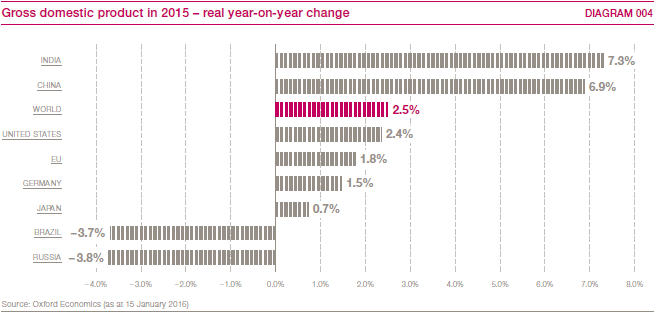Macroeconomic conditions
In 2015 the global economy expanded at a slower rate than in the previous year. This was mainly due to weak growth in key emerging markets such as China, Russia and Brazil. By contrast, the developed countries generally bolstered the global economy.
Besides GDP growth demand for industrial trucks is driven by industry’s investment confidence and world trade volumes. Here, too, there was a marked slowdown in global growth in 2015. The main factors in the cooling of global trade were the greatly reduced demand for imports in China and the resulting decline in commodity prices. In particular China’s major trading partners and the commodity-exporting countries were negatively affected. An increase in consumer spending and growth in the service sector had a positive effect, however, particularly on e-commerce and the demand for additional warehouse space.
In 2015, the Chinese economy saw its weakest growth in a quarter of a century. As the economy in China is transformed into one that is driven by consumption and services, it has been accompanied by a further slowdown in growth. The pace of growth also tailed off in the other Asian countries. An exception was India, where the economy continued to rally. Both consumer spending and industrial output increased visibly here.
Growth in Brazil and Russia continued to be strongly negative in 2015, in line with expectations, with domestic economic problems and low commodity prices having a negative impact. The eastern European EU states, however, recorded healthy growth. The region benefited from low oil prices and high levels of consumer spending and from the ongoing recovery in western Europe.
Alongside the USA, western and central Europe proved to be a pillar of the global economy. A solid performance from Germany and the recovery in southern Europe were the main drivers of growth in the eurozone. Most of the momentum came from consumer spending; global uncertainties meant that companies remained cautious in their investment decisions.
The USA benefited from an upturn in the labour and housing market. After a weak first quarter, its economy substantially picked up the pace as the year progressed. > DIAGRAM 004
